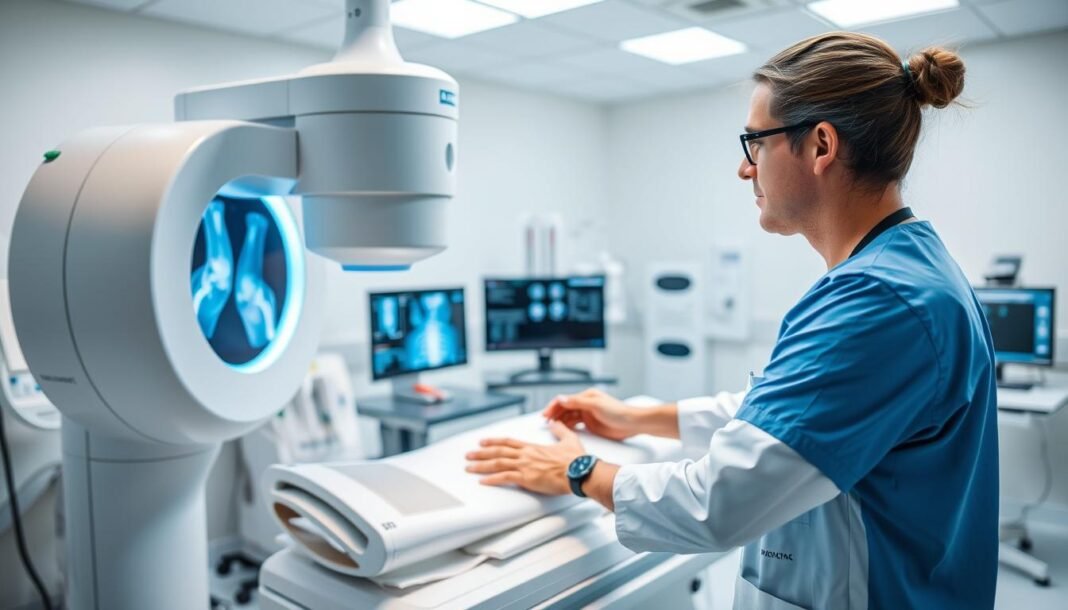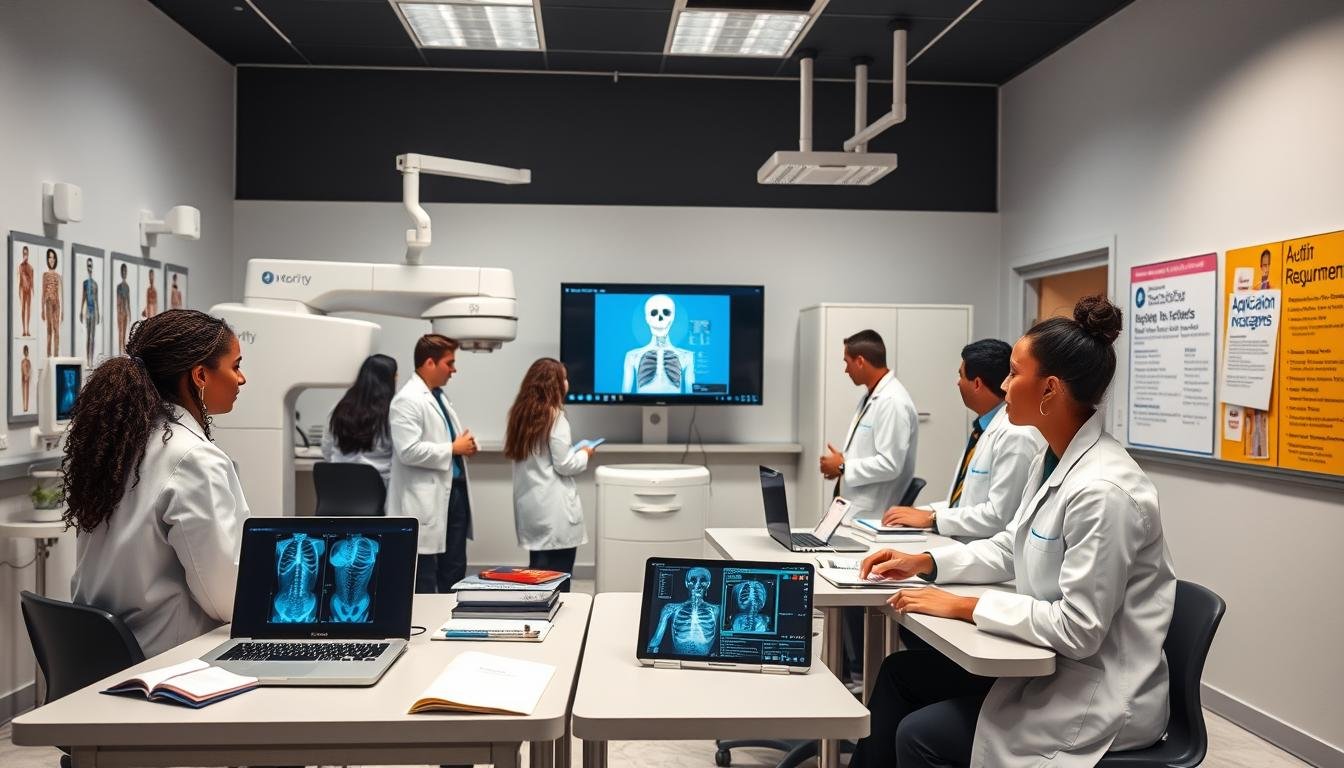X-ray tech schools train future radiologic technologists. These programs teach medical imaging, patient care, and radiation safety.
Students learn to use advanced diagnostic equipment. They gain hands-on experience in clinical settings.
This prepares them for certification exams. It also readies them for careers in healthcare facilities.
A modern radiologic technologist in a bright, sterile hospital environment, wearing scrubs and a lab coat, operates an advanced X-ray machine focused on capturing images of a patient lying on the examination table. Various medical equipment and monitors are in the background, and soft lighting highlights the professionalism and expertise of the technician.
X-ray tech schools launch rewarding medical careers. Graduates can work as radiologic technologists.
They perform vital imaging procedures. These help diagnose and treat many medical conditions.
The demand for healthcare pros is growing. Now’s a great time to explore x-ray tech education.
What is an X-Ray Tech School?
X-ray tech schools train students in medical imaging. They teach how to use X-ray equipment for diagnostic imaging. Students learn anatomy, radiation physics, and image interpretation.
These schools prepare students for careers as X-ray technicians. The goal is to teach how to capture high-quality medical images. Students gain skills through lectures, hands-on training, and clinical rotations.
X-ray tech school is essential for a career in medical imaging. It provides a strong foundation in radiologic technology, and students develop skills to become competent X-ray technicians.
Choosing the right school can lead to a rewarding career. X-ray technicians help patients and contribute to healthcare. Their work is vital for diagnosing and treating illnesses.
Benefits of Attending X Ray Tech School
X-ray tech programs offer many advantages for future radiologic technologists. Graduates can work in hospitals, clinics, and imaging centers.
Many programs have flexible schedules for working students. This helps balance education with other commitments.
X-ray tech schools provide hands-on clinical experience. Students learn practical skills in real healthcare settings.
This experience builds essential skills for success as an X-ray technician and prepares students for the realities of the profession.
X-ray tech schools often have strong industry connections. These connections help graduates find jobs more efficiently.
The right program can jumpstart a medical career with confidence. Students can become professionals seamlessly with school support.
How to Choose the Right X-Ray Tech School
Picking the best x-ray tech program is key to a great career. Look for schools with JRCERT accreditation. This ensures top-notch training that meets industry standards.
Check if the program covers anatomy, imaging methods, and radiation safety. Some schools offer unique tracks, such as CT or mammography.
Think about the school’s location. You may need to travel for clinical work.
Compare costs for tuition, fees, books, and supplies. Find a program that fits your budget.
Research graduation rates and job placement success. This shows how well the school trains students.
Admission Requirements for X-Ray Tech Programs
X-ray tech schools need a high school diploma or equivalent. Some schools want math and science courses, too.
Applications need transcripts, recommendation letters, and a background check. These help schools assess each student.
Many schools offer financial aid options. These include grants, loans, and scholarships.
Apply for financial aid early. This can boost your chances of getting help.
Understanding these steps can start your medical career. X-ray tech is a rewarding field to pursue.
A modern classroom setting equipped with X-ray machines and medical imaging tools featuring a diverse group of students in lab coats engaged in hands-on training. The room is bright and organized, with anatomy charts on the walls and various medical textbooks scattered around. Include an open laptop displaying digital imaging software and a bulletin board with application requirements and deadlines, all within a clean and professional environment.
Curriculum Overview of X-Ray Tech Programs
X-ray tech schools offer a wide-ranging curriculum for future radiologic technologists. Core courses include anatomy, physiology, radiation physics, and patient care.
Students gain hands-on experience through clinical rotations in various imaging modalities, including X-ray, computed tomography (CT), and magnetic resonance imaging (MRI).
Many programs offer specialized tracks or electives in radiologic technology. Students can explore interests in mammography, nuclear medicine, or digital imaging.
X-ray tech programs aim to prepare graduates for successful careers. They balance theoretical knowledge with practical training in radiologic technology.
Students learn technical imaging skills and effective patient communication. The goal is to produce competent radiologic technologists ready for healthcare work.
Job Outlook for X-Ray Technicians
X-ray technicians have a bright future ahead. The field is growing faster than average through 2031.
This growth comes from increased demand for medical services. As people age, the need for diagnostic imaging rises.
The median yearly salary for x-ray technicians is about $61,000. Top earners can make over $92,000 per year.
Pay varies based on location, experience, and specialization. Urban areas and specialized clinics often offer higher salaries for X-ray techs.
Radiologic technologists have many growth chances. They can specialize in CT, MRI, or mammography.
Some move into management roles. Others pursue education in medical dosimetry or radiation therapy.
The job market for radiologic technologists is strong. It’s an excellent choice for those interested in healthcare.
Skills Needed to Succeed as an X-Ray Tech
X-ray techs need technical know-how and excellent patient care skills. They must also work with X-ray machines well and follow safety rules.
Reading images correctly is a key radiologic technologist skill. Strong patient care abilities are vital, too.
Good communication and teamwork help x-ray techs excel. Problem-solving skills are essential for unique patient needs.
Mixing technical expertise with people skills is crucial. This combo helps X-ray techs provide top-notch care.
Continuing Education and Certifications
X-ray technicians must stay up-to-date in radiologic technology. Continuing education is vital for professional growth and license renewal.
Advanced mammography, CT, or MRI certifications can boost skills and career prospects. These specializations enhance an X-ray tech’s expertise and job opportunities.
The American Society of Radiologic Technologists (ASRT) offers valuable resources. These include networking, courses, and industry updates to support ongoing learning.
Investing in certifications shows expertise and expands practice scope. It also ensures X-ray techs provide the best patient care possible.
Lifelong learning is key to the success of X-ray technicians. Pursuing advanced certifications and education opens doors to new opportunities.
This approach leads to professional growth and personal satisfaction, helping X-ray techs stay at the top of their field.
Getting Started at an X-Ray Tech School
Enrolling in an accredited x-ray tech school starts your healthcare career journey. Research programs that match your goals and submit your application with the required documents.
After acceptance, prepare for your first day. Review course materials and get needed supplies.
Connect with fellow students and instructors at orientation events. This will help you build a supportive network for your learning experience.
X-ray tech school is about more than just academics. It’s about joining the medical community and developing essential skills.
Learn from experienced faculty and work with your peers. Gain hands-on experience in clinical settings.
You’ll become a skilled X-ray technician with dedication and care for patients. Your journey to success begins here.
FAQ
What is an X-Ray Tech School?
X-ray tech schools train students in radiologic technology. They teach skills for using X-ray equipment and performing diagnostic imaging procedures.
The curriculum covers anatomy, radiation physics, and patient positioning. X-ray technology helps doctors diagnose and plan treatments for various medical conditions.
What are the Benefits of Attending an X-Ray Tech School?
X-ray tech school grads have many job options in healthcare. Programs often offer flexible schedules for working students.
Hands-on training in clinics builds real-world skills. Many schools have industry links to help grads find jobs.
How Do I Choose the Right X-Ray Tech School?
Pick a school with JRCERT accreditation. Check if the program covers key topics and offers specializations.
Think about the school’s location and program costs. Look at graduation rates and job placement success.
What are the Admission Requirements for X Ray Tech Programs?
Most programs need a high school diploma. Some ask for math and science courses.
You may need to submit transcripts and references. Many schools offer financial aid, so apply early.
What is the Curriculum Overview of X Ray Tech Programs?
Programs teach anatomy, radiation physics, and patient care. Students do clinical rotations to practice different imaging types.
Some offer specialties like CT or MRI. The goal is to prepare for certification exams and jobs.
What is the Job Outlook for X-ray technicians?
X-ray tech jobs are growing fast. Pay varies but is usually good.
You can advance by learning new imaging types. Some techs move into management or related fields.
What Skills Are Needed to Succeed as an X-Ray Tech?
X-ray techs need both tech and people skills. They must know imaging equipment and safety rules.
Good communication and teamwork are key. Problem-solving helps with patient needs and equipment issues.
What are the Continuing Education and Certification Options for X-Ray Techs?
X-ray techs must keep learning to stay current. Many states require ongoing education for licenses.
You can get special certifications in areas like mammography. Professional groups offer resources and courses for growth.
How Do I Get Started at an X-Ray Tech School?
Find accredited programs and apply. Once accepted, review materials and learn the schedule.
Meet other students and teachers at events. Building connections early can help your future career.
you may also read:Geekzilla Tech: Your Ultimate Guide to Tech Reviews
















